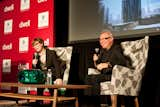Architect Daniel Libeskind on Optimism and Drawing at Dwell on Design NY
In the conversation, Libeskind spoke to his unconventional architectural training. In his early life, he wanted to be a musician, and only later changed gears. "Somehow, I fell into architecture," he said. Libeskind noted that drawing is the medium that has stayed consistent throughout his life. "In a way, everything is a form of drawing, even music," he said. "The act of drawing is more than we can fathom. There's something about it that is magical."
Libeskind is incredibly well-read, and also cited the influence that books have had on his life and practice. "Every great writer puts in doubt all other writers. That's a great thing, to rid your mind of preconceptions." Continually challenging one's own worldview is a strategy that is central to Libeskind's work. "As you gain experience, it becomes a disadvantage. You have to unlearn [as an architect]." He discussed how early on, he aimed to hire young architects with limited experience, as he believed they could approach the job with the least bias and preconception.
Finally, the architect, who was worked on a number of projects responding to loss—such as the Jewish Museum Berlin and the Ground Zero master plan—expressed that no matter what, optimism is architecture's key pillar. "If you're not an optimist, you shouldn't be in architecture," Libeskind said.
Published
Last Updated
Get the Dwell Newsletter
Be the first to see our latest home tours, design news, and more.


